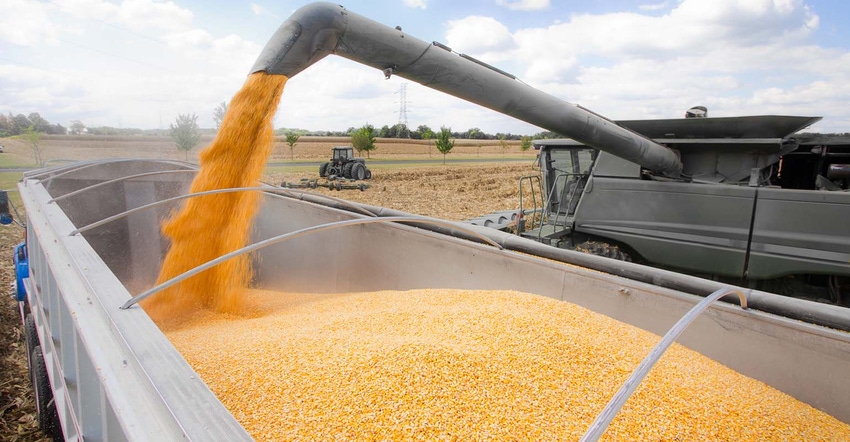
Opportunities to sell corn on flat price basis may be on hold now that USDA’s November crop report is in the books. The agency’s production, supply and demand update didn’t provide enough bullish news to justify big gains, and futures could languish until the next and final estimate of the crop’s size comes out in January.
But that doesn’t mean growers should sit back and do nothing. Strong basis in many areas is a chance to make some lemonade out of a market that’s been a lemon so far.
The slow pace of harvest to date, coupled with plenty of storage in many areas, has end users bidding up the cast market to lure corn out of the hands of farmers disappointed by the break in futures over the past month. While basis is fading in parts of the western Corn Belt like Nebraska and Kansas with better yields, elsewhere the cash market is on fire. Bids are still at double digit premiums to option in parts of the eastern Midwest, while basis moved above average at some terminals on the Illinois River, where deliveries will focus against December at the end of the month.
Some ethanol plants competing with the river are even offering free drying for the wet crop to attract feedstocks. Basis overall at plants was mixed last week but improved on average thanks to margins that ticked higher due to cheaper corn costs.
A dry forecast for the rest of November could bring more corn to town, but growers selling to markets feeding stretches of the Mississippi River due to close in a month may have the best shot at working a deal. Barge freight costs rose last week as shippers scrambled against the deadline despite a steady stream of empties moving up river as the annual rush to river close strengthens bids. Even with that demand barge freight costs don’t show more than a few pennies easing into summer as the industry anticipates steady shipments after the slow start to soybean exports caused by the trade war with China.
Carry in corn futures is around 3 cents a month per bushel, which might net a penny or so after costs, but it’s far from a slam dunk. Basis contracts could be an alternative on some corn, at least to generate some cash flow for prepaying inputs before the end of the year.
Soybean basis, meanwhile, has made a dramatic recovery from the very weak levels seen in the dog days of the trade war. That helped bids easily beat the roll to January as November went into delivery. The best indication of that was the November-January spread, which tightened more than six cents from its low on first position day.
Some processors even strengthened cash better than the roll to attract inventory in a highly competitive market, with the rally in soybean oil keeping margins decent. Carry in futures is running around a penny after interest. Like corn that may not be enough for growers who can find a buyer willing to push bids to fill a barge or keep the plant running.
Wheat demand hasn’t been great, but it’s good enough to force buyers to up their game too. Export markets off the Pacific Northwest and Texas and Louisiana Gulf strengthened, with bids steady to higher at most locations. The best markets remain from the northern Plains to the PNW. USDA confirmed lower spring wheat production Friday, and white wheat jumped as Australia gets ready to harvest one of its poorest crops in a decade.
Even sorghum basis strengthened last week, with basis at the Texas Gulf lifting rail bids into Kansas. China showed up as a buyer in last week’s export sales report as hopes for elimination of tariffs helped improve the mood.
The interactive maps below show how basis fared around the country. Click the box in the upper left-hand corner of the map to bring up the legend, and to turn features show on or off.
<div class="embed-container-google-map" embed-exclude=""><div class="embed-container-google-map" embed-exclude=""><iframe embed-exclude="" height="480" src="https://www.google.com/maps/d/u/0/embed?mid=1-kePBGILs4IsMVvEB3nHBF-buxY" width="640"></iframe><style embed-exclude="" type="text/css">
Download a complete version of the outlook with extensive charts and analysis using the Download button at the end of this report.
Bryce Knorr first joined Farm Futures Magazine in 1987. In addition to analyzing and writing about the commodity markets, he is a former futures introducing broker and is a registered Commodity Trading Advisor. He conducts Farm Futures exclusive surveys on acreage, production and management issues and is one of the analysts regularly contracted by business wire services before major USDA crop reports. Besides the Morning Call on www.FarmFutures.com he writes weekly reviews for corn, soybeans, and wheat that include selling price targets, charts and seasonal trends. His other weekly reviews on basis, energy, fertilizer and financial markets and feature price forecasts for key crop inputs. A journalist with 38 years of experience, he received the Master Writers Award from the American Agricultural Editors Association.
For more corn, wheat and soy news, commodity marketing recommendations and daily commodity charts, subscribe to Farm Futures' free e-newsletter, Farm Futures Daily, and keep up during the day with Farm Futures on Twitter.
About the Author(s)
You May Also Like






